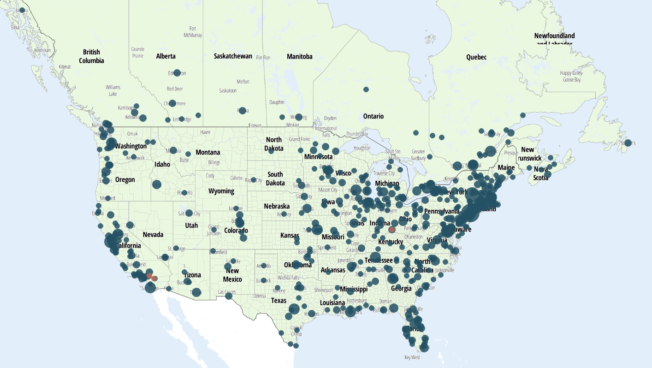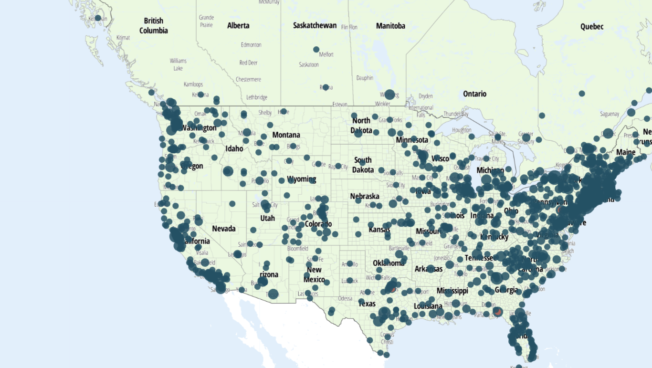Regional Overview
United States & Canada
November 2024
Posted: 9 December 2024
Demonstration trends
This section provides key figures on demonstration events, which includes incidents categorized as 'Protests,' and 'Violent demonstrations' as recorded by ACLED. For more information on event and sub-event types, see the ACLED Codebook
* This Regional Overview reflects ACLED data from 1 to 29 November. Data for 30 November will be available in the 10 December data release.
United States
602 demonstration events
33% decrease
compared to last month
Canada
226 demonstration events
107% increase
compared to last month
United States: Anti-Trump demonstrations spike following election results, but the situation remains peaceful
As votes from the presidential election rolled in on 6 November, it became clear that Donald Trump would be returning to the White House, claiming a decisive victory after carrying every swing state. Demonstrations were organized on the same day in reaction to the results. Anti-Trump demonstrations took place across at least 20 states and Washington, DC. As a result, anti-Trump demonstrations doubled in levels from the previous month and reached their highest single-month levels since January 2021, which saw rioting at the US Capitol. Across November, anti-Trump demonstrations were more than 40% higher than pro-Trump demonstrations, which continued at similar levels as in October. Meanwhile, demonstrations against Vice President Kamala Harris continued at the same levels as in October, while pro-Harris demonstrations declined slightly.
In the days before and after the election, conditions in the United States remained overwhelmingly peaceful. Though a few minor incidents of election-related violence — mostly involving fighting or assaults among individuals — took place across the country, they did not involve extremist groups and did not appear to impact the voting process (for more about election-related violence this year, see this Q&A with ACLED’s North America Research Manager Kieran Doyle).
Radical group trends
This section provides key figures on far-right and white nationalist groups.
Far-right groups:
ACLED uses this term to refer to a variety of actors, from 'traditional' militias to militant street movements. Though they are also analyzed separately, this figure also accounts for white nationalist and neo-Nazi groups.
White nationalists:
ACLED uses this term to refer to groups that openly describe themselves as white nationalist, white supremacist, or neo-Nazi.
* This Regional Overview reflects ACLED data from 1 to 29 November. Data for 30 November will be available in the 10 December data release.
58
events, of which 44 involve white nationalist groups
15
radical groups active, of which 9 are white nationalist
Radical groups were most active in Arizona
White nationalist groups were most active in Michigan
Group Spotlight:White nationalist activity in Canada
On 9 November, affiliates of Nationalist-13 and the Toronto Fitness Club, which is loosely affiliated with the Rise Above Movement’s network of Active Clubs in the United States and elsewhere, rallied in Hamilton, Ontario. The groups demanded mass deportation of immigrants and promoted white nationalist rhetoric. This is the second time ACLED has recorded the activity of Nationalist-13, a neo-Nazi organization run by former members of the now-defunct Steel City Proud Boys, in Canada.
White nationalist activity, which ACLED records across at least seven provinces, has taken place at a relatively regular frequency since ACLED began collecting data for Canada in 2021. However, the composition of active groups has shifted over this period. For example, the Finland-based group Soldiers of Odin was prevalent among white nationalist groups in Canada in 2021, having participated in several anti-LGBTQ+ demonstrations, but it has since retreated to relative inactivity. On the other hand, loosely networked chapters of white nationalist groups like Active Clubs and White Lives Matter have become more common in Canada since mid-2022. This still-nascent trend mirrors a similar phenomenon in the United States, which has seen white nationalist groups become substantially more prevalent in recent years (for more on white nationalist and other extremist group activity in the United States, see ACLED’s US Crisis Monitor report). Indeed, US-based groups and chapters, which are often larger and more established, have begun to openly collaborate and network with white nationalist groups across the border. For example, in October, Michigan-based Active Club and Patriot Front affiliates jointly held a sparring training with Nationalist-13 in Windsor, Ontario.
White nationalist groups in Canada have been substantially less prolific than their counterparts in the US. This is perhaps partially due to the Canadian government’s propensity to crack down on extremist groups. For example, the Proud Boys have been prohibited and designated as a terrorist organization in Canada since May 2021.1Emma Jacobs, ‘Proud Boys Named “Terrorist Entity” In Canada,’ NPR, 2 May 2021 However, though government terrorist designations may serve as a deterrent to the radicalization of individuals, it is not clear how impactful they have been on the existing memberships of white nationalist groups. The recent formation of Nationalist-13 shows how former Proud Boys members have been able to form splinter groups to continue their activities. Similarly, former members of Atomwaffen Division, a neo-Nazi group also designated as a terrorist entity by the government in 2021, have been documented joining Active Club chapters across Canada (for more about the structure of Active Clubs, see ACLED’s Group Spotlight in July’s North America Regional Overview).2Royal Canadian Mounted Police, ‘Two Ontario men arrested on terrorism charges,’ 8 December 2023 White nationalist groups often have overlapping membership, further complicating efforts to prevent their activities (for more on extremist mobilization, see ACLED’s US Crisis Monitor). Between the spread of loosely networked white nationalist chapters and reorganizing efforts of former members of banned groups, the landscape of white nationalist groups in Canada appears to be shifting.
See More
See the Codebook and the User Guide for an overview of ACLED’s core methodology. For additional documentation, check the Knowledge Base. Region-specific methodology briefs can be accessed below.
Links:
For additional resources and in-depth coverage of demonstration and political violence trends across the US, check our dedicated US Crisis Monitor.







